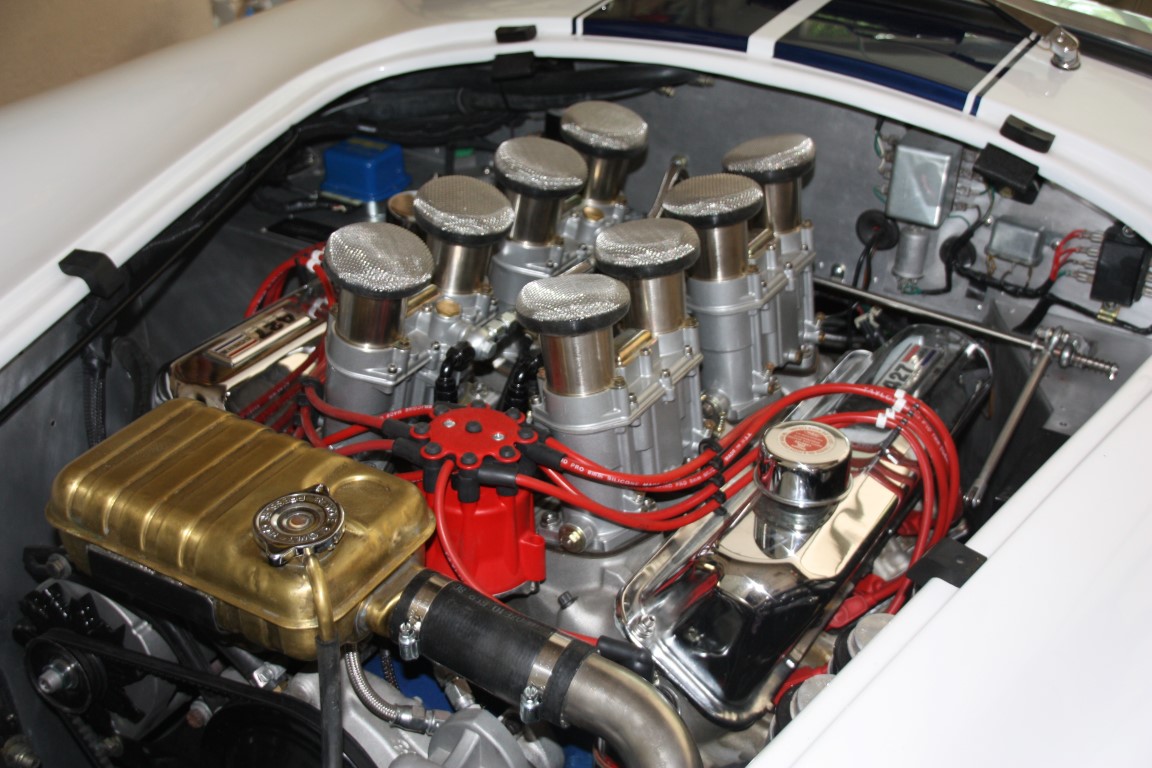WOW !
When the hood comes up and the eight individual throttles show, the reaction is almost always “WOW!” The FE with a set of Webers or ITB’s (Individual Throttle Bodies) is a very impressive setup, especially when its in a vehicle as small as a cobra.
The first use of Weber carburetors on these cars was on the small block FIA cars. One of the many items employed to get more horsepower out of the 289. The next appearance was then on the GT40 MKII however they were short-lived since Ford opted for a single four barrel. I don’t know all the findings as the Ford engineers decided to step back to a single carburetor however it is a documented fact.
And the use of Webers in the Big Block cars? To our knowledge, the only original outfitted with them was CSX3033 and that was the result of an after-delivery change by the owner. The car left the Shelby facility with the normal carburetion system.
The Webers on top the big block FE appear to be a natural fit, and in the cobra engine compartment, it’s easy to see why it became a big hit with the replica gang. But the Webers weren’t the easiest thing to work with. They have their ideosyncracies. But when the injection systems came around and were perfected, the only issue with them now is the cost of the system. The benefits are quick to overcome the period-correct Webers
Pro's
Con's
Webers
- Wow factor
- Period Correct
- Throttle response
- minimize cam lope
Injection
- Wow factor
- Period Correct
- Throttle response
- minimize cam lope
- fuel economy
- improved starting
- reliability
Webers
- not user friendly
- expensive
- complicated tuning
- air density issues
- requires special fuel regulator
Injection
- requires new fuel pump, regulator and return line
- requires electrical system changes
- Expensive
- Tuning can be complicated
Comments on each of the points
- Wow Factor – self explanatory
- Period Correct – Webers and look alike Eight Stack systems replicate the units used in the sixty’s
- Throttle response – Horsepower is directly related to how much air can you get into the engine. The eight ports not only let in more air but more and quicker
- Because of the air path into the engine, the individual runners will tend to smooth any cam lope. It is a noticeable change
- fuel economy – it isn’t unreasonable to see a 50% or more improvement with injection
- Improved starting – a properly tuned injection system will start almost instantly
- Reliability – once an injection system is installed and properly tuned, it is pretty much trouble-free
- Not user friendly – the Webers (and injection) are infinitely adjustable, and one change will impact multiple areas. Tuning becomes very complicated. With Webers, there are eight of everything so change one jet size requires buying eight jets.
- Expensive – $$$$
- Complicated tuning – see above
- Air Density issues – as humidity and/or altitude change, the amount of oxygen reaching the chamber differs, which will impact the tune of the engine.
- Fuel System
- Webers – fuel pressure must be regulated to 2-4 psi or flooding occurs
- Injection – fuel pressure must be increased to 40-60 psi and excess returned to the fuel tank, requiring a return type regulator and line
- Electrical System – Injection systems are controlled by a computer (ECU) and must have a solid electrical system. Any drop in voltage due to wiring or switch issues will create ECU problems. Additional sensors are required air and coolant temp, 02 sensors, ignition and timing. The original cobras had 10 wires in the loom. An injection system will have over 50
- Expensive – add another $ since dyno tuning is typically involved
- Tuning an injection system can be complicated if you are not fully educated/understanding of injection systems and engine control. The learning curve from carburetion to injection is very steep.
Either system has one inherent problem – cost. At the time of this writing (early 2023), a set of Webers, manifold, and linkage costs approximately $4,800. A similar injection system is about the same but you must add $2,500 for fuel upgrades and ECU & sensors. Either system will then need about another $2,000 for installation and tuning. Bottom line, Webers will run about $7,500, and an injection system about $10,000.
A word of caution about pricing. There are some less expensive imports coming from off-shore. Both clone carburetors and clone injection systems. Due to the design of the system, they are subject to very fine tolerances to work properly. They are intolerant of slop, loose or improper throttle blade fit and other manufacturing tolerances. This is definitely one area that you “get what you pay for” The legal term is “Caveat Emptor” – Buyer Beware.




